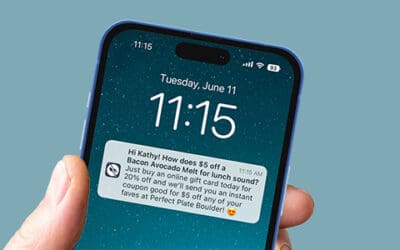
Mobile App AI: Forget Customer Opt-Outs and Focus on Opt-Ins
When considering implementing a mobile app AI like LighthousePE, it’s easy to get caught up worrying about the potential of customer opt-outs. Instead, however, I’d encourage you to focus your attention on the customers who choose to opt in—customers who already have a relationship with and an affinity toward your brand. You shouldn’t miss the invaluable opportunity to communicate with your most loyal audience at the risk of opt-outs from less engaged customers.
The Road to First-Party Data
Today, just about every website and mobile app asks if it can track you. The current industry-wide average opt-in rate for mobile app tracking is 34%, up from 29% in 2022. The overall push notification opt-in rate is 60%. For LighthousePE, the average opt-in range we see is consistently 68% to 71%, with older and younger generations typically representing the highest rates of opt-in tracking.
A brand’s obsession with collecting first-party data is the result of years of privacy concerns over third-party data. After the General Data Protection Regulation (GDPR) and California’s Consumer Privacy Act (CCPA) cracked down on websites and apps using cookies to track customers without their knowledge, companies had to figure out a new—and legal—way to collect customer data themselves. Now just about every app you download and every website you visit prompt you to consent to share your data with the brand.
Understanding Customer Opt-In
Prompts to opt-in work incredibly well with customers who trust a particular brand. For example, people who download the Pechanga Resort Casino app are already fans of the brand. They have a relationship with the casino. And they recognize the rewards that opting in can offer. In this case, casino customers are gamblers—of course they want deals. Pechanga Resort Casino can capitalize on that opt-in by establishing their mobile app as an engaging, relevant communication channel for their customers. That kind of personalized engagement can increase brand loyalty as well as revenue.
Guardrails for Communication
Customer opt-in does not grant brands free rein. Communicate with your opt-in audience responsibly, beginning by following the written rules of opt-in communication: Offer customers the opportunity to opt out. Refrain from selling customer data. Only use data as it applies to your brand.
The written rules of opt-in communication are critical, but it’s the unwritten rules that make or break your relationship with your customers. These rules are steeped in trust. Following these rules helps your brand enhance customer relationships using opt-in communication.
Frequency of Communication: Be mindful not to overcommunicate. Your customers don’t want to receive endless push notifications or emails.
Relevance of Communication: Make sound use of the customer information you collect to provide your customers with information that’s relevant to them.
Respect for Customers: Respect your customers’ time. Don’t ask them to do more or give you more information.
I recently experienced a violation of these unwritten rules with a T-shirt brand I love. They requested to email me my receipt and assured me that I wouldn’t receive their emails. About three weeks later, I got an email from them. I love the brand, so I thought, “If I get these emails every once in a while, that’s cool.” Then I got an email from them every day for the next eight days. Needless to say, I unsubscribed. Will I still buy their T-shirts? Probably, but my opinion of the brand isn’t the same.
To help your brand follow both the written and unwritten rules, LighthousePE is designed with guardrails around communication frequency and relevance. When a customer updates or installs your mobile app, we have effective messaging in place that speaks to concerns about tracking and opt-in. After all, it’s all first-party data that cannot be sold. Plus, Lighthouse is built with security and privacy at its core, and it’s GDPR and CCPA compliant.
Focus on the Opt-In
Customer opt-in presents an invaluable opportunity to build stronger relationships with your most engaged customers. You can’t control the customer opt-outs, but you can control how your brand communicates with those who opt in.
Your brand’s mobile app is not just a one-way utilitarian device. It’s a distinct communication channel owned—and controlled—by your brand. And mobile app AI like LighthousePE allows you to communicate relevant deals, experiences, and messages that are unique to each individual customer to help them feel special, like you understand them. That’s how you create customers for life.
If you’d like to learn more, contact me at [email protected] or book a time to speak with me here.
You may also be interested in
How the Right AI Can Expand the Casino Player Experience
Most casinos aren’t fully embracing AI, and, in turn, they’re missing opportunities to take care of their existing players and outpace their competition. Unrealized potential awaits—from enjoying the benefits of a true attribution channel to delighting players with...
How AI Automation Will Drive Mobile App Marketing Success
As much as we may hate to admit it, our smartphones and the apps on them have become an essential part of our lives. We use them for everything. They help us order food, shop, bank, and be entertained. Consider this fact: Last year, the number of holiday purchases...
Drive Business Growth Through the Power of Push Notifications
Have you ever received a push notification on your phone that grabbed your attention? Perhaps it was a discount code from your favorite store or an alert about an event you were keen on attending. The key factor that made it stand out among the clutter on your lock...
Overcommunicating with Your Customers Is Worse than Not Communicating at All
It recently hit me that I’ve been getting tons of emails and push notifications from brands. I started monitoring it. When I realized how bad some of the communication was, I got frustrated and started unsubscribing. And that’s what brought me here: overcommunicating...






